Toubou people
The Toubou, or Tubu (from Old Tebu, meaning "rock people"[4]), are an ethnic group inhabiting northern Chad, southern Libya, northeastern Niger and northwestern Sudan. They live either as herders and nomads or as farmers near oases. Their society is clan-based, with each clan having certain oases, pastures and wells.[5]
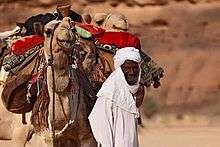 Toubou man travelling in the desert | |
| Total population | |
|---|---|
| 2,250,000 | |
| Regions with significant populations | |
| 1,370,000 | |
| 580,000 | |
| 160,710 | |
| 139,290 | |
| Languages | |
| Tebu (Dazaga,[1] Tedaga[2]), Arabic, French, English | |
| Religion | |
| Islam (Sunni)[3] | |
The Toubou are generally divided into two closely related groups: the Teda (or Téda, Toda) and the Dazagra (or Dazaga, Dazagara, Daza). They are believed to share a common origin and speak the Tebu languages, which are from the Saharan branch of the Nilo-Saharan language family.[6] Tebu is divided further into two closely related languages, called Tedaga (Téda Toubou) and Dazaga (Dazaga Gouran).
The Teda of the Toubou live in the far north of Chad, around the borders of Libya and Niger and the Tibesti Mountains. The Dazagra people are found in northern Chad and part of eastern Niger and northwestern Sudan.[7] Of the two groups, the Dazagra, found to the south of the Teda, are more numerous with a population of 1,500,000, while the Teda number only 750,000.[8]
The Toubou people are also referred to as the Tabu, Tebu, Tebou, Tibu, Tibbu, Toda, Todga, Todaga, Tubu, Tuda, Tudaga, and Umbararo people.[2][3] The Dazaga are sometimes referred to as Gouran (or Gorane, Goran, Gourane), an Arabian exonym.[9] Many of Chad's leaders have been Toubou (Gouran), including president Goukouni Oueddei and president Hissène Habré.[10]
Distribution
The Toubou people have historically lived in northern Chad, northeastern Niger, and southern Libya. They have sometimes been called the "black nomads of the Sahara".[11] They are distributed across a large area in the central Sahara, as well as the north-central Sahel. They are particularly found north of the Tibesti mountains, which in Old Tebu means "Rocky Mountains." Their name is derived from this.[12]
The Teda are found primarily in the Sahara regions around the borders of southeast Libya, northeast Niger and northern Chad. They consider themselves a warrior people. The Dazagra live towards the Sahel region and are spread over much of north-central Chad. The Dazagra consist of numerous clans. Some major clans of the Dazagara, or Gouran, include the Anakaza, Dazza, Donza, Gaida, Kamaya, Karra, Kokorda, Mourdia, Wanja, Yierah, and Choraga. The Dazagra cover the northern regions of Bourkou, the Ennedi Plateau, the Tibesti Mountains and Bahr el Gazel in the south. There is a diaspora community of several thousand Dazaga living in Omdurman, Sudan and a couple of thousand working in Jeddah, Saudi Arabia.
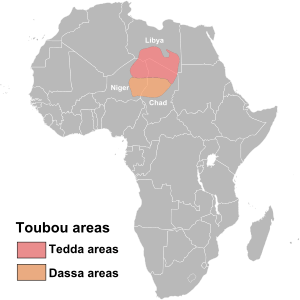
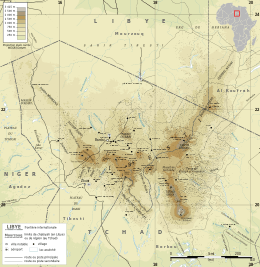
History
The ancient history of the Toubou people is unclear. They may be related to the 'Ethiopians' mentioned by Herodotus in 430 BCE, as a people being hunted by Garamantes, but this is speculative, as Jean Chapelle argues.[13][14]
In Islamic literature, the earliest mention as the Tubu people is perhaps that along with the Zaghawa people in an 8th-century text by Arabic scholar Ibn Qutaybah.[14][15] The 9th century al-Kuwarizmi mentions the Daza people (southern Toubou).[16] They represent 2.9% of the total population of Chad.
Society

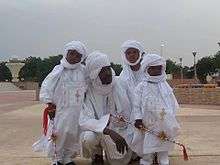
Livelihood
Toubou life centres on raising and herding their livestock, or on farming the scattered oases where they cultivate dates and grain and legumes. Their herds include dromedaries, goats, cattle, donkeys and sheep.[3] The livestock is a major part of their wealth, and they trade the animals.[12] The livestock is also used as a part of dowry payment during marriage, either as one where the groom’s family agrees to pay to the bride’s family in exchange for the bride,[3] or, states Catherine Baroin, it is given by the bride's kin to supply the young couple with economic resources in order to start a family.[17]
In a few places, the Toubou also mine salt and natron,[18][19] a salt like substance which is essential in nearly all components of Toubou life from medicinal purposes, as a mixture in chewing tobacco, preservation, tanning, soap production, textiles and for livestock.[20] Literacy rates among the Toubou are quite low.[21]
Family and clan
Many Toubou people still follow a nomadic pastoralist lifestyle. Those who prefer a settled life typically live in palm-thatched, rectangular or cylindrical mud houses.[3] The Toubou are patrilineal, with an elder male heading the lineage. The second order of Toubou kinship is to the clan.[22]
According to Jean Chapelle, a professor of History specializing in Chadian ethnic groups, the clan system developed out of necessity. Nomadic life means being scattered throughout a region; therefore, belonging to a clan means that the individual is likely to find hospitable clan people in most settlements or camps of any size. A second factor is the maintenance of ties with the maternal clan. Although the maternal clan does not occupy the central place of the parental clan, it provides ties. The third factor is protective relationships at the primary residence.[23][24]
Despite shared linguistic heritage, few institutions among the Toubou generate a broader sense of identity than the clan. Regional divisions do exist, however. During the colonial period (and since independence in 1960), Chadian administrations have conferred legality and legitimacy on these regional groupings by dividing the Toubou and Daza regions into corresponding territorial units called cantons and appointing chiefs to administer them.
Toubou legal customs are generally based on Islamic law, that allows restitution and revenge.[25] Murder, for example, is settled directly between the families of the victim and the murderer. Toubou honour requires that someone from the victim's family try to kill the murderer or a relative; such efforts eventually end with negotiations to settle the matter. Reconciliation follows the payment of the Goroga (Islamic tenet of Diyya), or blood money.[26] Among the Tomagra clan of the Teda people in the Tibesti region, there is a derde (spiritual head) who is recognized as the clan judge, and arbitrates conflict and levies sanctions.[27]
Social stratification
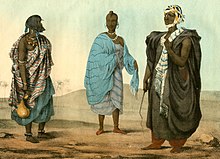
The Toubou people, states Jean Chapelle, have been socially stratified with an embedded caste system.[28][29] The three strata have consisted of the freemen with a right to own property, the artisanal castes and the slaves.[30][31]
The endogamous caste of Azza (or Aza) among Toubou have the artisanal occupations, such as metal work, leather work, salt mining, well digging, dates farming, pottery and tailoring, and they have traditionally been despised and segregated by other strata of the Toubou, much like the Hadahid caste in southeastern Chad among the Zaghawa people.[32][33] According to Paul Lovejoy – a professor of African History, the 19th century records show that these segregated Toubou castes followed the same customs and traditions as the rest of the Toubou, but they were independent in their politics and beliefs, much like the artisan castes found in many ethnic groups of eastern Chad such as the Kanembu, Yedina, Arab, Kouri and Danawa.[33]
Marriage between a member of the Azza and a member from a different strata of the Toubou people has been culturally unacceptable.[30][34] The language used by the Azza people is a variant of the Tebu language.[35]
The lowest social strata were the slaves (Kamaja).[29][36] Slaves entered Toubou society from raids and warfare on other ethnic groups in lands to their south. All slaves were the property of their masters, their caste was endogamous, and their status was inherited by birth.[37]
Marriage
The Toubou culture forbids marriage between first cousins, a practice common among many Muslim ethnic groups in Africa. A man may marry and have multiple wives according to Islamic tenets, however, this practice is only somewhat prevalent in Toubou society.[3]
The ownership of land, animals, and resources takes several forms. Within an oasis or settled zone belonging to a particular clan, land, trees (usually date palms), and nearby wells may have different owners. Each family's rights to the use of particular plots of land are recognized by other clan members. Families also may have privileged access to certain wells and the right to a part of the harvest from the fields irrigated by their water. Within the clan and family contexts, individuals also may have personal claims to palm trees and animals.
Contemporary conditions
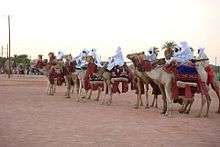
Chad
.jpg)
Much of the political class of Chad are drawn from Dazagra. During the First Chadian Civil War (1966-1979), the derde came to occupy a more important position. In 1965 the Chadian government assumed direct authority over the Tibesti Mountains, sending a military garrison and administrators to Bardaï, the capital of Tibesti Sub-prefecture. Within a year, abuses of authority had roused considerable opposition among the Toubou. The derde, Oueddei Kichidemi, recognized but little respected up to that time, protested the excesses, went into exile in Libya, and, with the support of Toubou students at the Islamic University of Bayda, became a symbol of opposition to the Chadian government. This role enhanced the position of the derde among the Toubou.[38]
After 1967 the derde hoped to rally the Toubou to the National Liberation Front of Chad (FROLINAT). Moral authority became military authority shortly thereafter when his son, Goukouni Oueddei, became one of the leaders of the Second Liberation Army of FROLINAT. Goukouni was to become a national figure; he played an important role in the battles of N'Djamena in 1979 and 1980 and served as head of state for a time. Another northerner, Hissène Habré of the Dazagra, replaced Goukouni of the Teda in 1982, and lost eventually power to the Zaghawa Idriss Déby after 8 years.
Libya
The Toubou minority in Libya suffered what has been described as "massive discrimination"[39] both under the leadership of Muammar Gaddafi as well as after the Libyan civil war.[21]
In a report released by the UNHCR, the Society for Threatened Peoples (STP) reported "massive discrimination" against the Toubou minority, which resides in the southeastern corner of the country around the oasis town of Kufra. In December 2007, the Gaddafi government stripped Toubou Libyans of their citizenship, claiming that they were not Libyans, but rather Chadians. In addition, local authorities denied Toubou people access to education and healthcare. In response, an armed group called the Toubou Front for the Salvation of Libya (TFSL) staged an uprising in November 2008 which lasted for five days and claimed 33 lives before being crushed by government security forces. Despite resistance and public condemnation, the Gaddafi regime continued its persecution of the Toubou minority in Libya. Beginning in November 2009, the government began a program of forced eviction and demolition of Toubou homes, rendering many Toubou homeless. Several dozens who protested the destruction were arrested, and families who refused to leave their homes were beaten.[39]
In the Libyan Civil War, Toubou tribespeople in Libya sided with the rebel anti-Gaddafi forces and participated in the Fezzan campaign against forces loyal to Muammar Gaddafi, briefly capturing the town of Qatrun[40] and claiming to capture Murzuk for the rebel movement a month later.[41]
In March 2012, bloody clashes broke out between Toubou and Arab tribesmen in the southern city of Sabha, Libya. In response, Issa Abdel Majid Mansour, the leader of the Toubou tribe in Libya threatened a separatist bid, decrying what he saw as "ethnic cleansing" against Toubou and declaring "We announce the reactivation of the Toubou Front for the Salvation of Libya to protect the Toubou people from ethnic cleansing." The TFSL was the opposition group active in the unrest of 2007–2008 that was "ruthlessly persecuted" by the Gaddafi government.[42]
See also
References
- Dazaga: A language of Chad, Ethnologue
- Tedaga: A language of Chad, Ethnologue
- Teda people, Encyclopædia Britannica
- MacMichael, Harold: A history of the Arabs in the Sudan and some account of the people who preceded them and of the tribes inhabiting Darfur. 1922.
- Copson, Raymond W. (1 January 1994). Africa's Wars and Prospects for Peace. M.E. Sharpe. ISBN 9781563243004.
- International Encyclopedia of Linguistics. Oxford University Press. 1 January 2003. ISBN 9780195139778.
- Smith, Andrew Brown (1 January 2005). African Herders: Emergence of Pastoral Traditions. Rowman Altamira. ISBN 9780759107489.
- Olson, James Stuart (1996). The Peoples of Africa: An Ethnohistorical Dictionary. Greenwood Publishing. ISBN 978-0313279188.
- First Encyclopaedia of Islam: 1913-1936. BRILL. 1993. p. 818. ISBN 978-9004097964.
- Young, Tom (1 January 2003). Readings in African Politics. Indiana University Press. ISBN 978-0253216465.
- Catherine Baroin (1997). Tubu: The Teda and the Dazagra(kreda/anakaza/daza). The Rosen Publishing Group. pp. 9–10. ISBN 978-0-8239-2000-6.
- Gertel, Prof Dr Jörg; Heron, Professor Richard Le (28 November 2012). Economic Spaces of Pastoral Production and Commodity Systems: Markets and Livelihoods. Ashgate Publishing, Ltd. ISBN 9781409490364.
- Zweig, Paul (1 January 1976). Three journeys: an automythology. Basic Books. ISBN 9780465086108.
- Smith, Andrew Brown (2005). African Herders: Emergence of Pastoral Traditions. Rowman Altamira. pp. 127–129. ISBN 978-0759107489.
- J. D. Fage; Roland Oliver (1975). The Cambridge History of Africa. Cambridge University Press. pp. 287–289. ISBN 978-0-521-20981-6.
- https://www.researchgate.net/publication/310791117_Chad_Genetic_Diversity_Reveals_an_African_History_Marked_by_Multiple_Holocene_Eurasian_Migrations
- Baroin, Catherine (1987). "The position of Tubu women in pastoral production: Daza Kesherda, Republic of Niger" (PDF). Ethnos. 52 (1–2): 137–155. doi:10.1080/00141844.1987.9981339.
- Cyr, Ruth (1 January 2001). Twentieth Century Africa. iUniverse. ISBN 9780595189823.
- Vikør, Knut S. (1 January 1999). The Oasis of Salt: The History of Kawar, a Saharan Centre of Salt Production. Centre for Middle Eastern and Islamic Studies. ISBN 9781850653080.
- Lovejoy, Paul E. (22 May 1986). Salt of the Desert Sun: A History of Salt Production and Trade in the Central Sudan. Cambridge University Press. ISBN 9780521301824.
- Cole, Peter; McQuinn, Brian (1 January 2015). The Libyan Revolution and Its Aftermath. Oxford University Press. ISBN 9780190210960.
- Ch. Le Cœur (1960), Reviewed Work: Nomades noirs du Sahara by Jean Chapelle, Annales de Géographie, 69e Année, No. 376 (Novembre-Décembre 1960), pages 632-635
- Chapelle, Jean (1982). Nomades noirs du Sahara: les Toubous (in French). Editions L'Harmattan. ISBN 9782858022212.
- Baroin, Catherine (1985). Anarchie Et Cohésion Sociale Chez Les Toubou: Les Daza Késerda (Niger) (in French). Les Editions de la MSH. ISBN 978-0521304764.
- Scheele, Judith (2014). "The values of anarchy: moral autonomy among Tubu-speakers in northern Chad". Journal of the Royal Anthropological Institute. 21 (1): 32–48. doi:10.1111/1467-9655.12141.
- Buijtenhuijs, Robert (2001). "The Chadian Tubu: Contemporary Nomads Who Conquered a State". Africa. 71 (1): 149–161. doi:10.3366/afr.2001.71.1.149.
- Rights, African Commission on Human and Peoples' (2009). Rapport Du Groupe de Travail de la Commission Africaine Sur Les Populations/communautes Autochtones : Mission en Republique de Niger 14–24 Février 2006 (in French). IWGIA. ISBN 978-8791563485.
- Chapelle, Jean (1982). Nomades noirs du Sahara: les Toubous (in French). Editions L'Harmattan. pp. 7–8, 343–344. ISBN 978-2858022212.
- Jean Cabot (1965), Trois ouvrages sur les populations du Nord du Tchad de Jean Chapelle, Annie Lebeuf et Albert Le Rouvreur, Annales de Géographie, Volume 74, Numéro 401, pages 104-107, Quote: "des castes particulières: Azza (forgerons, chasseurs, tanneurs), Azza (...)"
- Andrew B. Smith (2005). African Herders: Emergence of Pastoral Traditions. Rowman Altamira. pp. 135, 142. ISBN 978-0-7591-1502-6., Quote: ""Like the Tuareg, the Toubous have a distinct hierarchy, with three separate levels: Teda/Daza, Aza artisans and slaves. (...) [There] the blacksmiths were segregated from the larger populace and seen as contemptible. (...) No Teda/Daza would think of marrying a blacksmith. They are a caste apart, marrying only among themselves."
- Jean-Pierre Olivier de Sardan; Mahamam Tidjani Alou (2009). Les pouvoirs locaux au Niger. Paris: KARTHALA Editions. pp. 280–281. ISBN 978-2-8111-0306-4.
- H.A. MacMichael (1988). A History of the Arabs in the Sudan. Cambridge University Press. pp. 89–90 with footnotes.
- Paul E. Lovejoy (1986). Salt of the Desert Sun: A History of Salt Production and Trade in the Central Sudan. Cambridge University Press. pp. 147, 272–273. ISBN 978-0-521-30182-4.
- Catherine Baroin (1985). Anarchie Et Cohésion Sociale Chez Les Toubou: Les Daza Késerda (Niger). Les Editions de la MSH. pp. 187–188. ISBN 978-0-521-30476-4.
- William Frawley (2003). International Encyclopedia of Linguistics: AAVE-Esperanto. Vol. 1 (2nd ed.). Oxford University Press. p. 492. ISBN 978-0-19-513977-8.
- David J. Phillips (2001). Peoples on the Move: Introducing the Nomads of the World. William Carey Library. pp. 178–180, 193. ISBN 978-0-87808-352-7.
- Paul E. Lovejoy (1986). Salt of the Desert Sun: A History of Salt Production and Trade in the Central Sudan. Cambridge University Press. pp. 141–147, 274–275. ISBN 978-0-521-30182-4.
- Olympio, Francisco Kofi Nyaxo (11 December 2013). Neo-Panafricanism Foreign Powers and Non-State Actors. LIT Verlag Münster. ISBN 9783643904225.
- Summary prepared by the Office of the High Commissioner for Human Rights in accordance with paragraph 15 (c) of the annex to Human rights Council resolution 5/1: Libyan Arab Jamahiriya
- "Libya rebels report loss of Qatrun". The Daily Star Newspaper – Lebanon. Retrieved 21 November 2014.
- "Libya: Toubou rebels engage in battle against Gaddafi". Archived from the original on 7 November 2014. Retrieved 21 November 2014.
- "Libya's Toubou tribal leader raises separatist bid". Archived from the original on 15 August 2013. Retrieved 21 November 2014.
